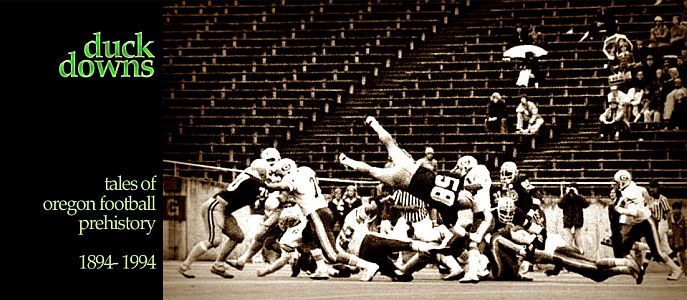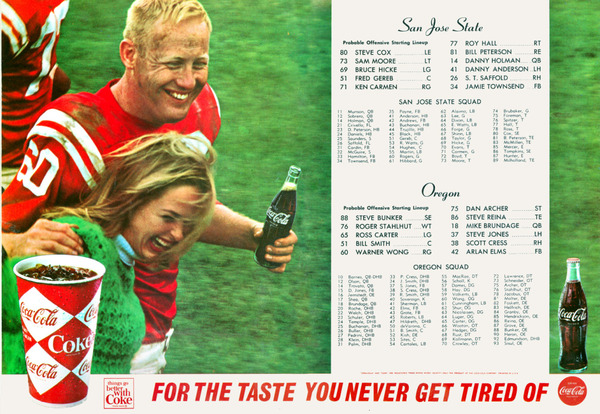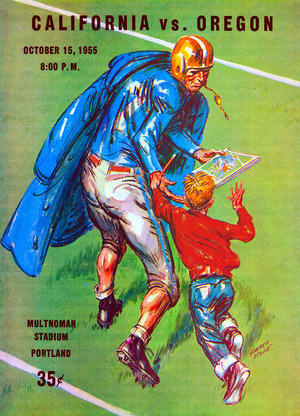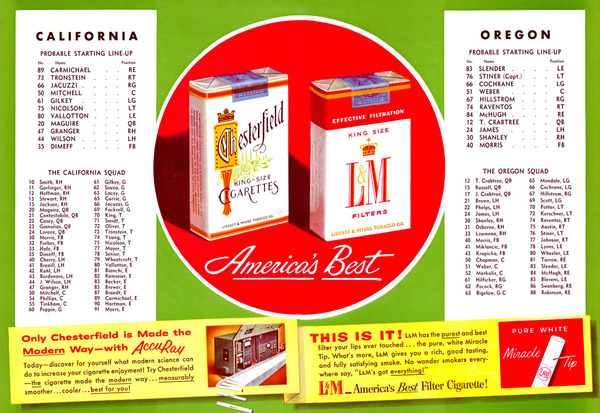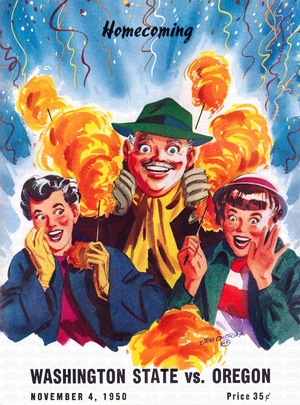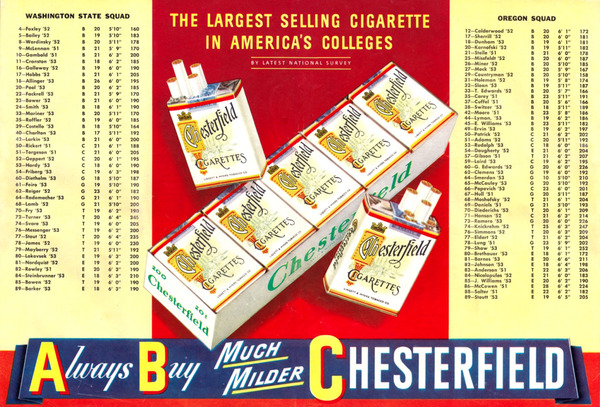October 1, 1966 – San Jose State at Oregon
 October 2, 2011
October 2, 2011 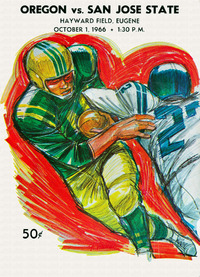 click to embiggenLen Casanova probably deserved better for his last season as Oregon head coach than a Bataan Death March of a schedule – only four home games, five of the last six on the road and an opener at Oklahoma. The slate was cobbled together in relative haste following the reunification of most of the old PCC teams into what would eventually become the Pac-8. Even with only four conference games, and without USC or UCLA on the schedule, Oregon’s cupboard was so barren of talent it was hard to see how the last campaign could amount to anything beyond an exercise in futility.
click to embiggenLen Casanova probably deserved better for his last season as Oregon head coach than a Bataan Death March of a schedule – only four home games, five of the last six on the road and an opener at Oklahoma. The slate was cobbled together in relative haste following the reunification of most of the old PCC teams into what would eventually become the Pac-8. Even with only four conference games, and without USC or UCLA on the schedule, Oregon’s cupboard was so barren of talent it was hard to see how the last campaign could amount to anything beyond an exercise in futility.
Only nine starters returned from the 1965 team, and that season ended with one win in seven games. Depth was such a concern that Cas announced to a group of incredulous touring Skywriters, in early September that at least ten players, including potential star backs Mike Barnes and Claxton Welch, would be groomed to play both sides of the ball – in the two-platoon era, a white flag if ever one was raised.
In his sixteenth season, Casanova, the lame-Duck dean of AAWU coaches – it didn’t officially become the Pac-8 until 1967 – did his best to stay on the sunny side. Acknowledging predictions of no better than a 7th place finish were “justified,” Cas said “they’re sure as hell not a collection of stars, but they are a dedicated outfit.” But even Cas couldn’t sugar-coat this turd. Referring to the “Ugly Ducklings,” the 1957 second-string unit that contributed greatly to the Rose Bowl season ten years earlier, Cas said “these fellows remind me a lot of them, only these guys are the first string, that’s the trouble.”
Who says they don’t play football just for fun anymore? They seem to be at Oregon … It wasn’t planned to be, it just worked out that way.
This is supposed to be the day of high-pressure recruiting and specialized, two-platoon football. But [Casanova] … told tales of players ‘who just kind of wandered onto campus’ and of iron-man types who will go both ways. Maybe it doesn’t follow, but the Webfoots also don’t expect to have a very good football team.”
– Al Moss, San Francisco Chronicle
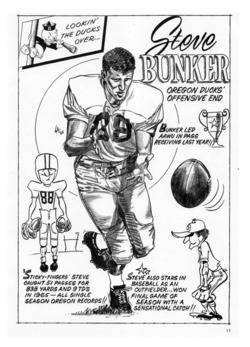 To make matters worse, the old “player’s coach” was dealing with player issues. Senior end Steve Bunker, who had set team records for receptions, yardage and touchdowns in 1965, reported to fall camp twenty pounds overweight and was put on a crash diet. Fullback Jim Evenson, a JC transfer from Boise who had performed well in spring ball, quit the team after learning he’d fallen behind Claxton Welch on the depth chart (he would return in 1967, played two seasons for Jerry Frei, and had a long career in the CFL). Senior halfback Scott Cress separated his shoulder in practice and was replaced for the Oklahoma opener by Roger Smith, still not fully recovered himself from a pulled hamstring. The only returning “stars” were Bunker, the nation’s leader in receptions, and DB Jim “Yazoo” Smith, both honorable mention all-conference in 1965.
To make matters worse, the old “player’s coach” was dealing with player issues. Senior end Steve Bunker, who had set team records for receptions, yardage and touchdowns in 1965, reported to fall camp twenty pounds overweight and was put on a crash diet. Fullback Jim Evenson, a JC transfer from Boise who had performed well in spring ball, quit the team after learning he’d fallen behind Claxton Welch on the depth chart (he would return in 1967, played two seasons for Jerry Frei, and had a long career in the CFL). Senior halfback Scott Cress separated his shoulder in practice and was replaced for the Oklahoma opener by Roger Smith, still not fully recovered himself from a pulled hamstring. The only returning “stars” were Bunker, the nation’s leader in receptions, and DB Jim “Yazoo” Smith, both honorable mention all-conference in 1965.
Thus, it wasn’t unexpected that Oregon would arrive at week three of the 1966 season with a winless record. What was unexpected, by coaches and fans and media, was the poor performance of the team, especially against Utah.
There’s a difference between playing well and losing and playing badly and losing. That was the difference between the Oklahoma and Utah games. The best thing the Ducks did Saturday afternoon was convince most of the 16,500 fans who watched that it’s going to be a long, dreary season.”
– Jerry Uhrhammer, Eugene Register-Guard
The senior co-captain at quarterback, Mike Brundage, had been miserable at Oklahoma, and not much better against Utah. Cas announced on Monday that the signal caller position was “wide open,” and after neither senior Tom Trovato nor soph Eric Olson made a convincing case during practice, sophomore Mike Barnes was moved from defensive back to QB. There would be a four-man competition for the job.
Whoever the quarterback would be wouldn’t have a lot to work with. Welch and #2 wingback Roger Smith were still recovering from leg injuries. And there were was a freak injury to starting tight end Steve Reina, the leading receiver after two games, who was injured at his frat house (ATO) after the Utah game; somehow, a sliding glass door was involved, and Reina took a large gash to his right leg, which required eight stitches. He spent the week on crutches.
***
Thus was the scene set for week three, which brought pass-happy San Jose State to Hayward Field. If there was a get-well game for the Ducks in the early season, this appeared to be the one. Also winless, SJS – seven point underdogs to the Webfoots – had lost to Stanford and BYU and suffered seven season-ending injuries in the process. But they had the nation’s top passer in Danny Holman, all 6’2” and 160 pounds dripping wet of him.
Oregon’s defensive backs weren’t impressed. Omri Hildreth acknowledged that Holman was “good and deceptive, but he throws the ball a little too soft.” Tim Temple was licking his chops: “He’s a football player with a basketball pass.. It’s not a hard pass and it even wobbles … The movies showed he throws off-balance.” Les Palm was succinct: “I’m ready and anxious for Saturday.” Only the veteran Yazoo Smith was reserved, saying “He’s not a bad thrower, and it looks like he has a lot of finesse.”
So the game went, four Oregon quarterbacks against one. The Webfoots watched as Holman shredded their secondary for 308 yards and three touchdowns in a 21-7 humiliation at Hayward Field. Oregon led at the half, 7-6, and had run 48 plays to the Spartans’ 14 to that point, but had five possessions inside the Spartans’ ten yard line – including a first-and-goal at the one — and only managed one touchdown. Mike Barnes had earned the starting job at QB, and Oregon’s offense at last showed some life, with 353 yards, but repeated mistakes doomed the Ducks on an unseasonably hot day in early October.
Holman picked the Duck secondary apart in the second half, going 18-22-0 for 252 after the break. Yazoo Smith did his best to stem the tide, seemingly trying to play all four DB positions at once, and garnered two interceptions. But the rest of Oregon’s secondary was humiliated.
They were playing our ends too tight. You tell them that. They were working too hard to stop the short pass and got killed with the long ones. They were also trying to stop our roll-outs. That hurt them too.
I think they underestimated our quarterback.”
—- SJS safety Steve Saunders
Those who doubt that Oregon football has reached the crisis stage, based on … cold facts, are kidding themselves.”
– Don Fair, The Oregonian
***
The loss was Oregon’s sixth straight over two seasons. The last hurrah for Len Casanova would end with a whimper at 3-7. There would be just one more game at Hayward Field, in November hosting Washington State, and that too would be a loss, meaning the last victory by the Webfoots at Hayward Field was a three point triumph over Idaho in 1965.
The Oregon athletic department was faced with the daunting task of moving an unsuccessful team off campus into a stadium with almost three times the capacity of its old stomping grounds. Then, in January 1967, the dominoes toppled. Leo Harris, possibly tiring of the constant battles with his boss, announced his resignation as athletic director. Casanova hung up his clipboard and took over for Harris, and longtime assistant Jerry Frei was named head coach.
Program Notes –
- This program is a little more content-rich than its predecessors of the decade, but the 1966 issues are still Fifties programs, more than halfway through the Sixties. The covers remain generic and boring, and by now they don’t even carry artist credits; they’re just drawings of football players.
- No more cigarette advertising! Not even “public service” messages. This had to have been by policy and not legislation, as print tobacco advertising continued to be legal and common in the US media well into the 1980s. Someone at the UO made a commendable decision to eschew tobacco dollars, and hooray for whoever made the call.
- For years there was a consensus view that if you put too many games on television, attendance at local games would suffer. This theory couldn’t be tested with any accuracy, of course, but it seemed to make sense to those who stood to lose money, and as a result the broadcast of games was severely – absurdly – restricted. Even the advertising walked a tightrope (see page 2 – “When you can’t get out to a game, watch NCAA College Football on the ABC Television Network”), as if watch Linfield play Whitman in person was preferable to staying home and watching Notre Dame play anyone. This view held until the Supreme Court overturned the monopoly on broadcast rights in 1984, after which nobody ever attended a college football game again.
- There’s a feature on the Alpha Tau Omega house. “President of the local chapter is football quarterback Tom Trovato.” ATO was a “jock house” fixture at Oregon for decades, until around 1999, when the frat was among the first to take a no-alcohol pledge. Sometime between then and now, it ceased to exist.
- Advertised automobiles: sublime (Buick GS-400) and ridiculous (Oldsmobile Toronado, con matador! “Toronado” was a word GM made up, and had nothing to do with bullfighting).
- The proofreader must have been on sabbatical. (“Herb Alpert and the Tiajuana Brass”… “schools of Achitecture and Allied Arts”)
- Center roster spread sponsored by Coke. Milk on the back cover. Who needs cigarettes?
 programs in
programs in  1966,
1966,  San Jose St
San Jose St 